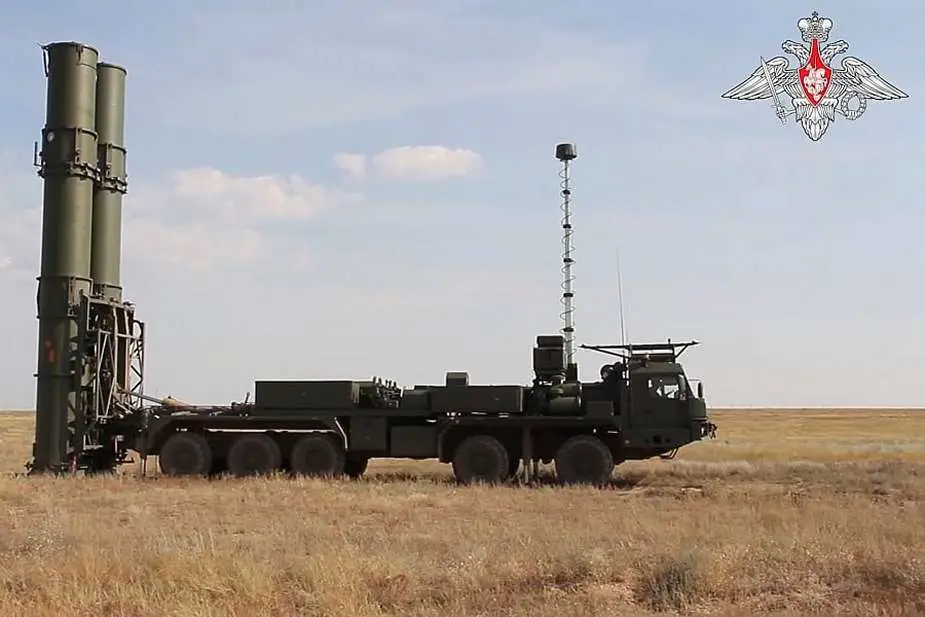Breaking news
Breaking News: Russia's S-500 Air Defense Missile System Proves Hypersonic Interception Capability.
Moscow, February 27, 2024 - S-500 Prometheus, the latest generation of Russian-made air defense missile system has demonstrated its capability to intercept and destroy hypersonic targets, following a comprehensive series of tests conducted by the Russian Ministry of Defense, according to a recent report by Izvestia citing sources within the military department.
Follow Army Recognition on Google News at this link

The S-500 Prometheus is the latest generation of air defense systems fully designed and developed by the Russian defense industry. (Picture source Russian MoD)
The final phase of the S-500's testing was conducted on February 22, 2024, showcasing the system's precision and advanced capabilities. The Prometheus successfully engaged and destroyed an R-29RMU2 Sineva intercontinental ballistic missile, which was launched by the Tula, an underwater nuclear-powered missile cruiser, from the Laptev Sea. The missile was intercepted over the Chizha training ground located in the Arkhangelsk region.
The S-500 system's testing phases were meticulously planned to validate its operational specifications, particularly its ability to counter hypersonic weapons, which represent a significant advancement in modern warfare technology. These weapons, known for their high-speed, maneuverability, and ability to evade traditional missile defense systems, pose a new challenge on the battlefield. The successful interception of the Sineva missile—a proxy for hypersonic targets—underscores the Prometheus' potential to enhance air defense capabilities significantly.
According to the Russian Ministry of Defense, the S-500 Prometheus has met all its expected performance parameters during the tests, confirming its readiness to counter both existing and future aerial threats. The system's ability to engage hypersonic targets effectively marks a significant milestone in air defense technology, positioning Russia at the forefront of missile defense capabilities.
The Russian Ministry of Defense has previously outlined plans to commence the deployment of the S-500 Prometheus system within its armed forces starting this year. The integration of Prometheus into Russia's military arsenal is anticipated to bolster the country's air defense network, providing an advanced layer of protection against a broad spectrum of aerial threats, including drones, stealth aircraft, and ballistic missiles.
The development of the S-500 Prometheus, Russia's advanced air and missile defense system, began in the early 21st century. Its development was officially announced in the late 2000s, to create a system capable of intercepting ballistic missiles, aircraft, and potentially hypersonic targets. The S-500 is designed to complement and eventually replace the S-300 and S-400 air defense missile systems, incorporating advanced technologies that enable it to engage targets at higher altitudes and longer ranges. The system's development has been characterized by a series of tests and evaluations, leading up to its expected deployment within the Russian Armed Forces. While specific dates for the commencement of its development vary, it is clear that significant progress was made throughout the 2010s, with key milestones in testing and development reported in the mid to late 2010s and into the early 2020s.
The S-500 Prometheus is distinguished by its remarkable technical features, tailored to enhance engagement capabilities against the most sophisticated aerial threats. At the core of its operational prowess is the system's ability to engage targets at extended ranges and high altitudes, a significant improvement over its predecessors. Specifically, the S-500 is designed to detect and intercept airborne targets up to 600 kilometers away, a range that allows for early detection and engagement of incoming threats well before they reach critical infrastructure or military assets. Furthermore, it boasts an operational altitude of up to 200 kilometers, enabling it to destroy targets in the near space environment, including low-orbit satellites, thereby extending the battlefield into space.
Moreover, the S-500 Prometheus system integrates advanced radar technology and command-and-control capabilities, ensuring seamless detection, tracking, and engagement of multiple targets simultaneously, including stealth aircraft and missiles that employ low-observable technology to evade detection. Its ability to intercept hypersonic missiles, which travel at speeds exceeding Mach 5, is particularly noteworthy. This is achieved through a combination of sophisticated sensors, high-speed interceptor missiles, and cutting-edge computing technology that calculates interception courses in real time. The S-500's interceptors are equipped with advanced propulsion systems, allowing for rapid acceleration and high maneuverability, essential for engaging fast-moving and agile hypersonic threats. This comprehensive suite of technical features positions the S-500 Prometheus as a formidable air defense system capable of countering a broad spectrum of aerial dangers, securing airspace with unparalleled efficiency and reliability.
Defense News February 2024























